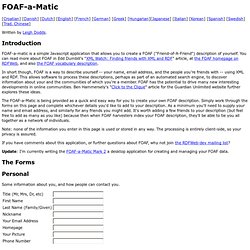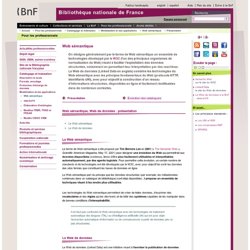

Plugin. Home Mondeca - Mondeca. Décrivez-vous en RDF. Written by Leigh Dodds.

Introduction FOAF-a-matic is a simple Javascript application that allows you to create a FOAF ("Friend-of-A-Friend") description of yourself. You can read more about FOAF in Edd Dumbill's "XML Watch: Finding friends with XML and RDF" article, at the FOAF homepage on RDFWeb, and also the FOAF vocabulary description. In short though, FOAF is a way to describe yourself -- your name, email address, and the people you're friends with -- using XML and RDF.
This allows software to process these descriptions, perhaps as part of an automated search engine, to discover information about your and the communities of which you're a member. The FOAF-a-Matic is being provided as a quick and easy way for you to create your own FOAF description. Note: none of the information you enter in this page is used or stored in any way.
If you have comments about this application, or further questions about FOAF, why not join the RDFWeb-dev mailing list? People You Know Generate Results License. Are Semantic Ads the Push that Semantic Technologies Need? Semantic technologies are maturing and this is good news because they can be used to fuel semantic ads, ads that promise a lot to both advertisers and publishers.

Still, if the technology is reliable, why don't we see more semantic ads? What is a Semantic Ad? The term "semantic ad" is somehow self-explanatory but in order to avoid confusion, I will define it as a type of ads, which use semantic technologies to determine the context of the page on which the ad will be served. Semantic ads go beyond the literal meaning of words on a page and try to capture the context. The idea is that this way more relevant ads will be served, which in turn will improve conversion.
Semantic ads are not mainstream. The development of semantic technologies isn't cheap and even though there is funding from sources like government — for example the IKS project got money from the EU — there is still much work to be done. If semantic technologies are making money, this will draw more investors. Web sémantique, Web de données : présentation. On désigne généralement par le terme de Web sémantique un ensemble de technologies développé par le W3C (l'un des principaux organismes de normalisation du Web) visant à faciliter l'exploitation des données structurées, notamment en permettant leur interprétation par des machines.

Le Web de données (Linked Data en anglais) combine les technologies du Web sémantique avec les principes fondamentaux du Web (protocole HTTP, identifiants URI), avec pour objectif la construction d'un réseau d'informations structurées, disponibles en ligne et facilement réutilisables dans de nombreux contextes. Le Web sémantique Le terme de Web sémantique a été proposé par Tim Berners Lee en 2001 (« The Semantic Web », Scientific American Magazine , May 17, 2001) pour désigner une évolution du Web qui permettrait aux données disponibles (contenus, liens) d’être plus facilement utilisables et interprétables automatiquement, par des agents logiciels .